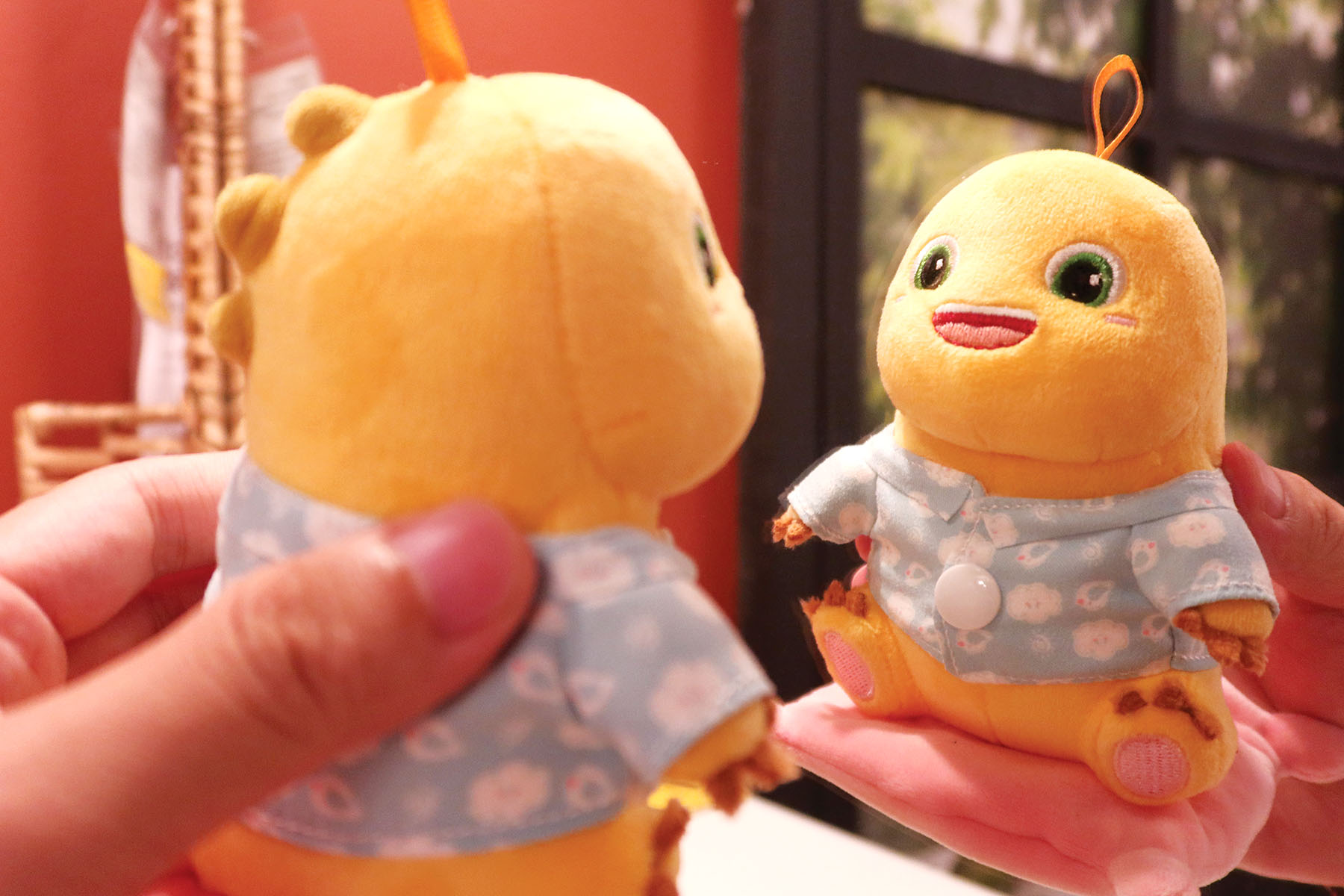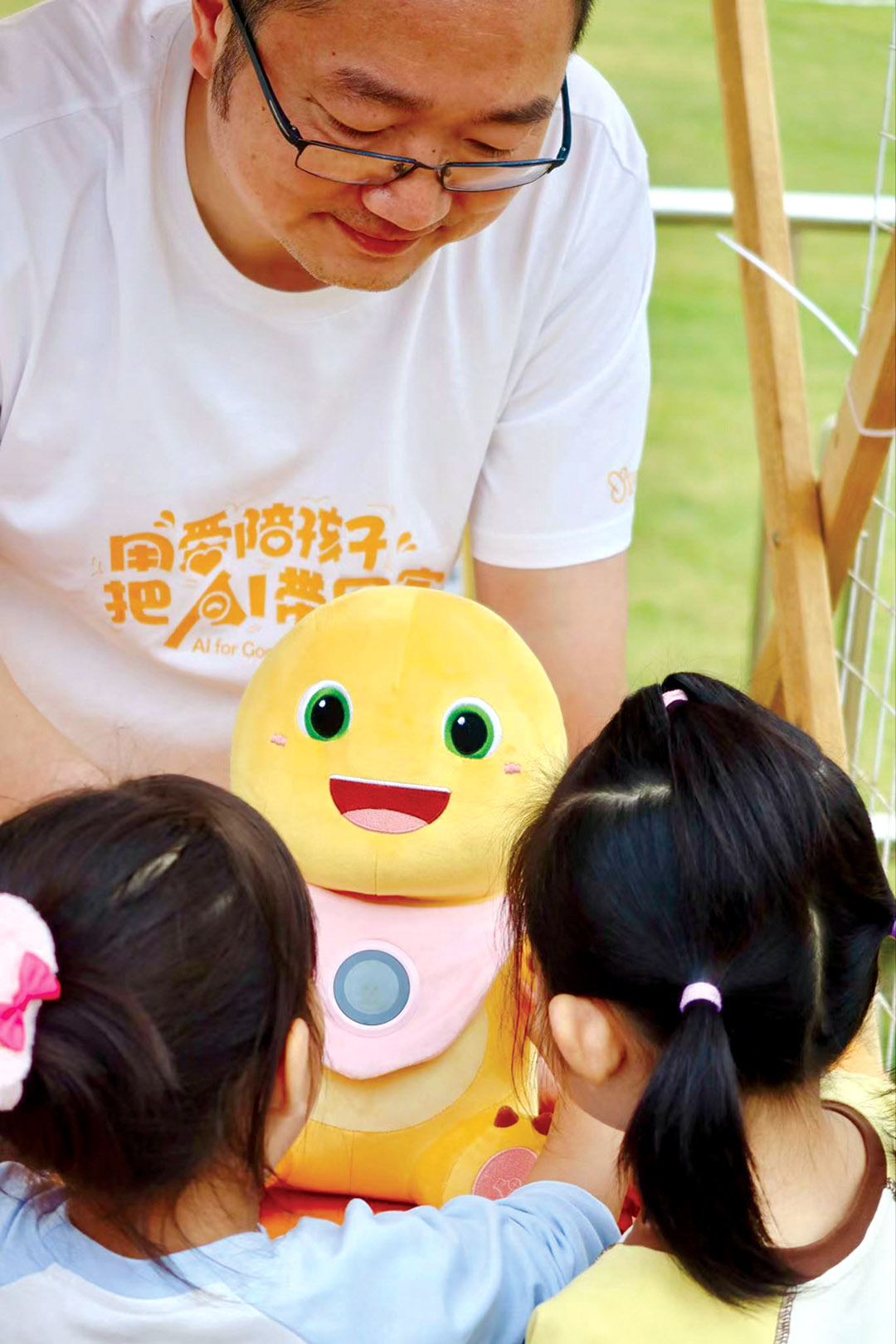Artificial intelligence toys have made a global breakthrough as humans’ trusted confidants despite initial apprehension. As Wu Kunling reports, industry experts envisage digital life-forms accompanying people in all stages of their lives in the future.

As their car traversed Shenzhen Bay Bridge, Stacy Wang watched her five-year-old son ignoring her in favor of his new confidant — a chubby yellow plush dinosaur named Nailong.
The toy instantly delivered a vivid introduction of the passing scenery, sparking a dialogue that left Wang and her son amused and amazed.
Wang, who lives in Shenzhen, bought the artificial intelligence-powered talking companion for her children, aged five and 10. Unlike conventional voice toys with preset responses, these innovative playmates engage children in real-time conversations while syncing with applications on smartphones. The system provides daily interaction reports, emotion analysis, suggestions for parents, and even alerts about untoward happenings like potential bullying.
Powered by a large language model (LLM) and enriched with child psychology expertise, the cuddly playmates represent a new frontier in play. The popularity of AI-powered companion dolls exploded after they were displayed, alongside other smart toys like robotic dogs, at the International Consumer Electronics Show in Las Vegas earlier this year. That followed exponential growth in the industry in 2024, hailed by analysts as the “breakout year” for AI toys, with these intelligent agents making their way into homes worldwide.
Wang’s sons became bonded with their AI companion in the blink of an eye, treating it as a tutor and playmate. They consult it while doing their homework, share stories with it and even confide in it about their personal problems. One of her children recently said to Nailong, “I made mommy angry. What should I do?”
READ MORE: Chinese tech firms up ante on open-source AI models
Initially cautious, Wang monitored all the interactions. While drawn to AI’s educational potential like many other parents, she is worried about generic AI tools that might mislead children. Her solution was to choose a camera-free, push-to-talk toy, rather than a voice-activated toy, with age-appropriate content filters.
She soon found the system adapting to responses based on her sons’ age groups and handling sensitive topics with care. When “fighting” came up, the toy offered constructive advice that soon won Wang’s approval and, gradually, her reservations faded.
“Early, gentle exposure to AI is crucial,” she says. “Whether we like it or not, their entire generation will grow up intertwined with AI.”

Playmates full of potential
The proliferation of AI-powered toys reflects the maturation of LLMs, with these toys serving as an ideal vessel for Al companionship, says Gibson Guo Zhi, CEO of Shenzhen Yijia Yiban Intelligent Technology — the company behind the Nailong digital toy.
By 2024, the tech industry had recognized LLMs’ commercial potential in enabling “small talk”, prodding a global wave of innovators — from toy giants to leading tech firms like Tesla, Casio and ByteDance — to merge intellectual property and create companion-focused digital life-forms.
A report by CSC Financial last year highlighted AI toys as one of the top LLM applications, citing strong user retention and higher spending. Global asset manager Ark Invest expects the revenue created by the AI companion market to reach $70 billion by 2030, growing at over 200 percent annually from 2024.
Innovators have been pursuing diverse approaches to win customers’ hearts. Some AI agents detect owners’ emotions and respond through sounds and gestures, creating pet-like nurturing satisfaction. Others, like Guo’s Nailong, provide verbal companionship.
“We want every child to have a Doraemon-like friend,” says Guo, referring to the robotic cat from the hit Japanese manga series of the same name, known for offering friends unwavering support via futuristic gadgets. He envisions digital companions that blend into daily life to become children’s trusted confidants. According to Guo, small-scale trials in schools have shown promising results. Children now initiate storytelling, saying “Let me tell you a story” to the toy rather than just making requests, increasingly viewing these toys as “alive”.
Despite their popularity, Guo says that a core challenge these toys still face is enhancing their believability. For example, when a child asks about how to avoid homework, standard LLMs give proper but impersonal responses — failing to deliver a genuine sense of companionship. While current models surpass Wikipedia in knowledge, good AI companions require human-like emotions, memories and engaging interactions to truly meet user expectations.
This reveals a critical gap — authentic AI companionship needs more than just embedding language models into hardware. Guo stresses the need of comprehensive data systems capable of deeply understanding children and responding to their emotions appropriately. His team is working with child psychologists and educators in conducting extensive family interviews to achieve this.
Yet, many parents overlook these needs, believing conversational ability and basic math proficiency alone make such toys sufficient. This perception has pushed some manufacturers to cut corners by skipping rigorous data training and oversight to reduce costs. Guo warns that such negligence could harm children, with inadequate safeguards that could create dangerous outcomes.
Last year, a lawsuit filed in Florida in the United States pointed to the dark side of AI companionship. After her son took his own life, a grieving mother sued an AI company, blaming a “deceptive, addictive” chatbot for manipulating her child.
Guo is worried that the industry may face a prolonged “bad money driving out good” scenario. However, he remains optimistic for the sector’s future, noting that strong consumer demand for emotionally valuable products, ranging from games to plush toys, shows the market’s potential.
His team has gone beyond children’s toys to adult companions and potentially eldercare solutions for cognitive impairment. Guo envisions digital soulmates evolving even beyond physical forms — appearing as wearables or cloud-based assistants like Iron Man’s Jarvis. “This could unlock infinite possibilities,” he says, predicting ubiquitous AI companions in everyday life.

Friends for a lifetime
In the future, digital life-forms will accompany human beings in all stages of their lives, says Ma Xiaojuan, associate professor in the Department of Computer Science and Engineering at the Hong Kong University of Science and Technology.
The seasoned expert in human-computer interaction says academia and industry are making progress moving toward this vision, empowering such agents to serve as our playmates, assistants, partners, spiritual guides or caregivers.
Many academics and industry insiders envision a single agent that accompanies individuals throughout their lives, playing different roles along the way. “However, due to problems like data asset management, it’s more likely we’ll have multiple digital companions through diverse phases of life,” she says.
A growing number of people have begun embracing digital life-forms. In Ma’s view, there are profound technological and emotional reasons behind this trend. These digital beings use sensors, cameras, microphones and other tools to perceive human behavior. Some are advanced enough to capture physiological signals, such as body temperature, heart rate, electrodermal activity indicating stress levels, and skeletal posture that could indicate falls. They analyze these signals to make increasingly accurate judgments about our physical condition and current mood.
And, they go far beyond merely understanding more about humans. The rapid advancement of LLM has reduced the development cycle and costs of such products, enabling humans to imbue digital beings with various identities, background stories and personalities. Such innovation enables them to become more human-like, says Ma.
What is more significant is that when people confide in digital beings, they need not worry about the agents being emotionally burdened or judging them, unlike interactions with real people. Available round-the-clock, AI companions just patiently provide emotional support whenever it is needed.
As an intriguing example, digital romantic partners and AI-powered romance games are gaining immense popularity worldwide, Ma notes, highlighting the significant societal craving for AI companionship.
Given the rapid growth of this expansive market, with AI being one of the most sought-after majors today, Ma stresses the importance of ongoing close collaboration and mutual oversight between academia and industry.
She says industry and academia form a highly complementary relationship as companies boast richer resources like the computing power of graphics processing units, while academia brings a wealth of experience in technical design and research practices to the table. Their close partnership drives the swift commercialization of AI research outcomes, and should remain a steadfast direction for the future.
At the same time, both parties must share the responsibility of mutual restraint to advance the field in a sustainable and healthy manner.
Ma notes that when making decisions and setting priorities, the industry is primarily driven by commercial interests, whereas academia is tasked with enhancing societal welfare and human development. She suggests that industry and academia work together to find a balance point that’s commercially valuable and socially responsible. They should collaborate to establish a set of standards within the field.
What worries her is that the AI companion market still lacks a mature regulatory framework, resulting in various aspects like data management and privacy protection being inadequately regulated, and having to rely solely on companies to self-regulate. She calls for both sides to join forces and advance this agenda.
For ordinary people immersed in this vast wave of technological innovation, the swift evolution of AI companionship has created an equally urgent, but long-term task: How can we comprehend and get along with the digital life-forms that accompany us?
Partners growing together
Ma says that whether we truly regard these digital entities as life-forms akin to humans or not, we are actively or inadvertently reshaping our behavioral norms and societal standards during our interactions with them. If our engagements with them always take on negative, domineering, or exploitative tones, these behaviors will gradually loop back to shape our personalities and self-awareness, eventually impacting how we interact with real people around us.
AI relationships require careful guidance — children who exhibit aggression toward digital companions without being corrected may transfer such behavior to their peers or pets. Similarly, adults immersed in digital romances must recognize that AI interactions do not equate to human relationships, lest they develop inappropriate real-world social behaviors.
People must move beyond seeing AI as mere tools, says Ma. “The true value comes when we grow together — emotionally, psychologically, and socially — through these relationships.” She suggests that parents gift AI companions thoughtfully, starting with a ceremonial unboxing to foster a positive first impression. Much like teaching a child to care for a pet, parents should actively observe interactions, address misbehaviors and intervene before habits are formed.
ALSO READ: Much potential to be tapped in AI cooperation
Ma emphasizes the need for parents to initiate a transparent dialogue, such as explaining to children AI companions’ capabilities and drawbacks, including how these tools may require a degree of privacy disclosure to parents in order to ensure minors’ safety. She adds that parents can take this opportunity to define “privacy” concretely together with their children, and collaboratively explore ways of interacting with the toys. “It isn’t just about the toys. It’s about guiding children to navigate the technology as mindful partners, instead of being passive consumers,” she says.
In the future, as more elderly people start using AI companions, their adult children should also follow suit. “This kind of education is the demand our era places on us,” Ma says.
Contact the writer at amberwu@chinadailyhk.com


